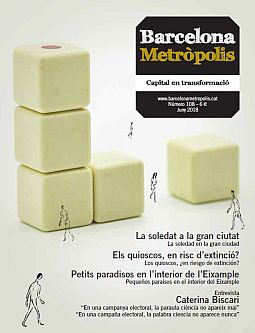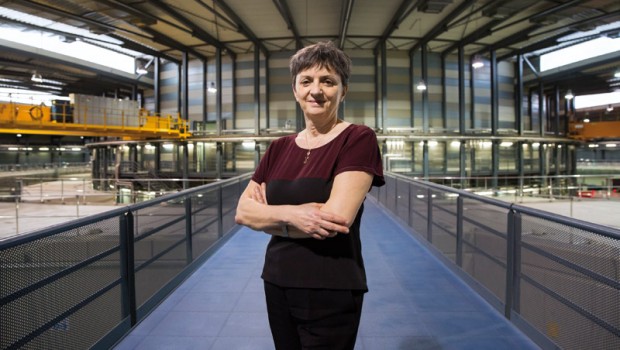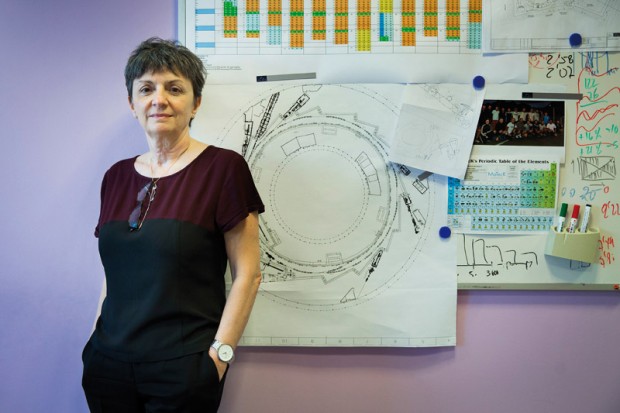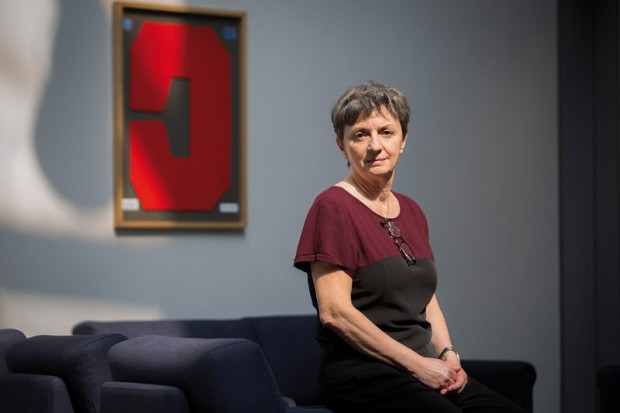Alba is the most important synchrotron light laboratory in the Mediterranean and south-west Europe. However, it is a great unknown for Barcelona society in general.
In Cerdanyola del Vallès, a 300-metre circumference ring, in which electrons orbit at the speed of light, lets us see how matter is constituted. The Alba synchrotron is a giant microscope whose light shows us what things are made of and whose precision lets us determine the position of atoms. Spanish-Italian Caterina Biscari has been director of this particle accelerator, the most important one in the Mediterranean and south-west Europe, since 2012, two years after its official inauguration. Biscari, an experimental physicist with experience in accelerators, is also a member of various international advisory groups, like the European Organisation for Nuclear Research (known as CERN for its French initials) based in Geneva.
How does the Alba synchrotron work?
When we go for an X-ray, the rays go through our body to give a photograph of our interior. Here we do the same, but the light we use is synchrotron light, a type of radiation emitted by electrons that travels at close to the speed of light. The accelerator, a 300-metre ring, has eight windows giving onto laboratories where researchers can observe matter. Their samples can be anything from cells to materials like the lithium in mobile batteries.
Alba is the most important synchrotron light laboratory in the Mediterranean and south-west Europe. How can there be people who know about CERN’s large hadron collider (LHC) but don’t know the Alba synchrotron is here?
Spanish society doesn’t understand the importance of research and this gets reflected in politics. In an election campaign, the words ‘science’ and ‘research’ never appear, and this is very serious. If society doesn’t demand that politicians invest in science, politicians will never do it on their own initiative because they’ve got a lot of other interests and urgent matters. What’s more, investment in science is long term and the government turnover rate is much quicker. Our project began in 2003, with José María Aznar and Jordi Pujol as heads of the Spanish and Catalan governments respectively. It was inaugurated in 2010 by José Luis Rodríguez Zapatero and José Montilla, in the same posts; we started working in 2012 and its usefulness has been seen in recent years and will be more visible in the future. If you ask a politician to invest in research and tell them they’ll see the fruits in five years’ time, they won’t do it, especially if it doesn’t bring them any votes. And for it to bring them votes, it’s got to be society who asks for it. We need to educate society; it’s an overdue issue, but it takes time and resources to do it.
In what way does the Alba synchrotron differ from the CERN accelerator?
The technology is the same. The accelerator follows the same principles here as it does there. But there are two main differences when it comes to purpose and size. The first –and main– difference is that CERN is used for pure science, to understand how matter is made up, without taking into account possible applications. Here, though, we do more applied science. Secondly, CERN is an international organisation in which 30 countries, among them Spain, take part. Its accelerator is one hundred times bigger (30 kilometres as compared to 300 metres) and the budget is much bigger.
A structure like CERN can only exist as the fruit of international collaboration. It’s not a structure a single country could afford; not even the United States could afford it. All the same, we work closely with CERN; there’s a constant flow of information and people. We share future projects on new acceleration techniques. We’re part of the same community.
There are different types of accelerator. Here you have a linear accelerator, a 300-metre propulsion ring and a storage ring. What is each one for?
The particles are produced by a heavy metal, tungsten, which contains a lot of electrons. When this metal is heated to more than a thousand degrees Centigrade the charged particles escape and enter the first linear accelerator, where they’re fed energy from electric fields and they reach almost 10% of their final energy.
Then they’re put into one of the circular accelerators where the electrons are accelerated to their final energy of 3 giga-electron volts. Next they’re taken from this first ring and injected into the second, where thanks to the magnetic fields they’re given a circular trajectory, so that they orbit and give off synchrotron light.
You currently have eight operative beamlines devoted to two communities: life sciences and the science of materials. Is one of these lines of research more prevalent than the others?
I’d say they’re equal. Of the eight lines of research, we can say that four are devoted to life sciences and the other four to the science of materials. A lot of them, though, are given a double use. For example, the X-ray diffraction crystallography line allows the study of a protein or a crystal. In this case, 95% is devoted to life sciences research and the other 5% to the science of materials, respectively. But there are other lines where it’s the other way round.
This is certainly an example of the multidisciplinarity of science we hear so much about.
Sometimes, when I have a particularly difficult day, I take a walk around the synchrotron experiment hall and talk to the researchers. You go from the scientist studying the malaria virus to the scientist analysing 5,000-year-old Iranian glass to understand how they were made. It’s incredible. It’s a privilege to be able to be here and be of use to so many scientific communities.
The synchrotron has also been used to investigate curiosities like the taste of chocolate and what yellow Van Gogh used.
One Barcelona company used our facilities to analyse how the structure of chocolate changes depending on the industrial process it undergoes. In other words, how cooling it, heating it or the amount of sugar affect the taste. Another curious experiment analysed Iberian ham. In this case, they put a sample through the synchrotron to see if it really was Iberian. When they did it, we asked them not to limit the sample to one millimetre [she laughs]. The synchrotron has plenty of applications in the food industry, such as studying the composition and the proportions of certain minerals in certain foods (selenium in potatoes, for example). Food is a very important issue for the future of humanity, both for those of us with a high standard of living who can afford to choose and for providing food for countries where there are serious problems of malnutrition.
Alba has a privileged position straddling knowledge, business and industry.
The idea to build the Alba synchrotron here was no whim. This location was chosen because it fulfilled various requirements. First of all, the geological studies showed that the site was stable and was of the quality needed for a structure of this sort. Secondly, it’s great to be next to the Autonomous University and the Parc de l’Alba economic activities park where numerous companies have offices. It was thought the park would grow faster but the crisis stopped a lot of investments. Now the economy’s beginning to move again and businesses are beginning to emerge that could become synchrotron users, in sectors such as cosmetics and mechanics. What’s more, the location is great because of the proximity to Barcelona. We benefit from the city’s power of attraction and the good connection with the airport.
What does it mean for the Alba synchrotron to be in Barcelona?
A lot. It gives us an enormous added value. Barcelona is seen almost everywhere, especially in Europe, as a very pleasant place to live, to spend a few days, to go to carry out an experiment. We’re a user facility. If users come here and they like it –and not just because the experiment works and the equipment’s good–, they’ll be back. That’s the way it goes. It’s true that users look more closely at the scientific aspect, but add to that that it’s a nice place and obviously that’s better. And not only that. The attraction Barcelona exerts also makes for the arrival of staff from outside Spain. Now 22% of the workforce is foreign, from 18 different nationalities. At the same time, Barcelona has a very powerful science structure thanks to the policy in support of research developed mainly by the Catalan government minister Andreu Mas-Colell. Alba is one of the results of that.
How does the synchrotron position us on the international map?
Very well. When I speak to my colleagues from outside Barcelona I find we’re on the scientific map as one of the best synchrotrons in Europe and the world. Barcelona shows up as the home of a very important construction. But the city doesn’t take enough notice of it, I think it ought to be able to profit from its presence. The presence of the synchrotron in the metropolitan area is a matter of general interest, but very little is known about it. Let me give you an example to help understand what I’m saying. The last synchrotron to have been built after Alba is in Sweden and in the two years it’s been in operation the king has already made several visits to it. Here it’s not just the king who doesn’t visit; not even the Mayor of Cerdanyola comes. The Mayor of Barcelona, Ada Colau, was supposed to visit, but in the end she didn’t and she delegated in the first Assistant Mayor, Gerardo Pisarello, whose presence among us, obviously, I thought was wonderful. Carles Puigdemont was also here a few months ago. What I mean is that, yes, there is some contact with politicians, but not enough. Barcelona should take advantage of us more. We’re well known in the academic world thanks to the excellence of our equipment, the operation we do and the services we offer. These are facts the scientific world knows and appreciates, unlike society in general.
The Woman’s Week Foundation has made you Woman Scientist 2018. Does the glass ceiling also exist in science?
The glass ceiling is everywhere, in any field. The thing is that in science there aren’t many of us to start with. It’s true that now we see a lot more young women scientists; I hope that’s because the situation’s changing. But the glass ceiling is a general problem in society; it’s a fact that changes very slowly. The situation in Spain isn’t good, but it’s not one of the worst, either. My appointment as Director of the Alba Synchrotron shows that here there were no negative feelings due to my being a women. If we look at all the comparable institutions we’ve got in Europe, apart from CERN –which now has a woman director, the Italian Fabiola Gianotti, for the first time in its 60 years of history–, the Alba Synchrotron is the only one run by a woman. In Germany, France, England, Italy, Sweden…, this sort of post is held by men in every case.
We ought to add that in areas like physics women have even less of a presence than in other fields like biomedicine.
In physical sciences we’ve always been few in number and we still are. I lecture on the physics of accelerators at the Autonomous University of Barcelona. This year the proportion of female students has improved slightly and is now around 30%. The other day, I was correcting partial exams and, for the first time in three years, I found an exam in which all four exercises were solved perfectly. The student was a girl.
I think it’s very important to act in schools. Our social model forces girls to accept the idea that they have to do something of use to others, so they study medicine, teaching, nursing… For his part, what does the physicist want? The physicist wants to understand why; he’s curious, that’s what makes him study physics. It’s a selfish process. When I studied physics it was because I wanted to understand more, even if afterwards I did things that were very useful for society.
That, then, is what girls ought to be taught. First of all, that they mustn’t be afraid of being selfish and studying whatever they want, just because they feel like it. And secondly, that anything they study in order to understand it will be of use to society. And they’ll be of use to society because, even if they don’t cure patients directly, they’ll facilitate the synchrotron with which they’ll improve the drug the patients are given so that, afterwards, there’s a better of chance of success. It’s an indirect way of helping, but it’s just as useful. This is the message we need to get across to society.
What is the advantage of having women scientists as models?
I’m very pleased with Fabiola Gianotti’s visibility around the world. I’m sure she’s convinced a lot of girls to study physics, because it shows you can study something you like and be useful. Social models must change. This year the #MeToo campaign was launched in Hollywood in an atmosphere that’s got nothing to do with science but that speaks for progress in general education in the sense that certain issues can no longer be handled like they have been up till now. Campaigns of this sort are positive in all fields and I hope they’ll also help in the world of science.






